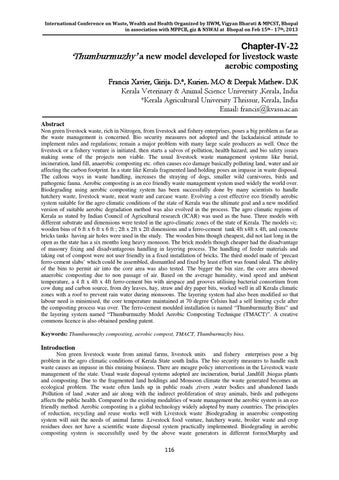International Conference on Waste, Wealth and Health Organized by IIWM, Vigyan Bharati & MPCST, Bhopal in association with MPPCB, giz & NSWAI at Bhopal on Feb 15th - 17th, 2013
Chapter-IV-22 ‘Thumburmuzhy’ a new model developed for livestock waste aerobic composting Francis Xavier, Girija. D. D.*, Kurien. M.O & Deepak Mathew. D.K Kerala Veterinary & Animal Science University ,Kerala, India *Kerala Agricultural University Thrissur, Kerala, India Email: francis@kvasu.ac.in Abstract Non green livestock waste, rich in Nitrogen, from livestock and fishery enterprises, poses a big problem as far as the waste management is concerned. Bio security measures not adopted and the lackadaisical attitude to implement rules and regulations; remain a major problem with many large scale producers as well. Once the livestock or a fishery venture is initiated, then starts a salvos of pollution, health hazard, and bio safety issues making some of the projects non viable. The usual livestock waste management systems like burial, incineration, land fill, anaerobic composting etc. often causes eco damage basically polluting land, water and air affecting the carbon footprint. In a state like Kerala fragmented land holding poses an impasse in waste disposal. The callous ways in waste handling, increases the straying of dogs, smaller wild carnivores, birds and pathogenic fauna. Aerobic composting is an eco friendly waste management system used widely the world over. Biodegrading using aerobic composting system has been successfully done by many scientists to handle hatchery waste, livestock waste, meat waste and carcase waste. Evolving a cost effective eco friendly aerobic system suitable for the agro climatic conditions of the state of Kerala was the ultimate goal and a new modified version of suitable aerobic degradation method was also evolved in the process. The agro climatic regions of Kerala as stated by Indian Council of Agricultural research (ICAR) was used as the base. Three models with different substrate and dimensions were tested in the agro-climatic zones of the state of Kerala. The models viz. wooden bins of 6 ft x 6 ft x 6 ft ; 2ft x 2ft x 2ft dimensions and a ferro-cement tank 4ft x4ft x 4ft, and concrete bricks tanks having air holes were used in the study. The wooden bins though cheapest, did not last long in the open as the state has a six months long heavy monsoon. The brick models though cheaper had the disadvantage of masonry fixing and disadvantageous handling in layering process. The handling of feeder materials and taking out of compost were not user friendly in a fixed installation of bricks. The third model made of ‘precast ferro-cement slabs’ which could be assembled, dismantled and fixed by least effort was found ideal. The ability of the bins to permit air into the core area was also tested. The bigger the bin size, the core area showed anaerobic composting due to non passage of air. Based on the average humidity, wind speed and ambient temperature, a 4 ft x 4ft x 4ft ferro-cement bin with airspace and grooves utilising bacterial consortium from cow dung and carbon source, from dry leaves, hay, straw and dry paper bits, worked well in all Kerala climatic zones with a roof to prevent rain water during monsoons. The layering system had also been modified so that labour need is minimised, the core temperature maintained at 70 degree Celsius had a self limiting cycle after the composting process was over. The ferro-cement moulded installation is named “Thumburmuzhy Bins” and the layering system named “Thumburmuzhy Model Aerobic Composting Technique (TMACT)”. A creative commons licence is also obtained pending patent. Keywords: Thumburmuzhy composting, aerobic compost, TMACT, Thumburmuzhy bins.
Introduction Non green livestock waste from animal farms, livestock units and fishery enterprises pose a big problem in the agro climatic conditions of Kerala State south India. The bio security measures to handle such waste causes an impasse in this ensuing business. There are meagre policy interventions in the Livestock waste management of the state. Usual waste disposal systems adopted are incineration, burial ,landfill ,biogas plants and composting. Due to the fragmented land holdings and Monsoon climate the waste generated becomes an ecological problem. The waste often lands up in public roads ,rivers ,water bodies and abandoned lands .Pollution of land ,water and air along with the indirect proliferation of stray animals, birds and pathogens affects the public health. Compared to the existing modalities of waste management the aerobic system is an eco friendly method. Aerobic composting is a global technology widely adopted by many countries. The principles of reduction, recycling and reuse works well with Livestock waste .Biodegrading in anaerobic composting system will suit the needs of animal farms .Livestock food venture, hatchery waste, broiler waste and crop residues does not have a scientific waste disposal system practically implemented. Biodegrading in aerobic composting system is successfully used by the above waste generators in different forms(Murphy and
116
